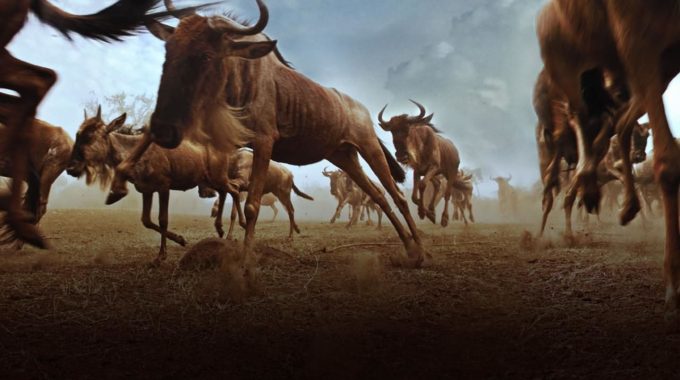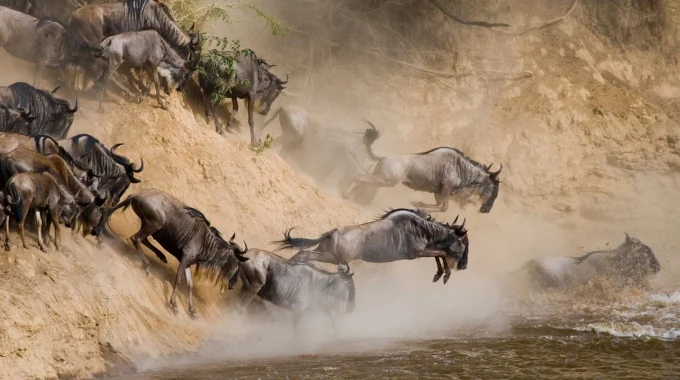How fast do wildebeest reproduce? - Wildebeests (Connochaetes spp.) are iconic members of the African savannas…
When should I go to Tanzania safari?
When should I go to Tanzania Safari? – The best time to go on a safari in Tanzania depends largely on what kind of experience you’re seeking, but for most travelers, the dry season (June to October) is considered the optimal time to visit. Here’s a breakdown of the key seasons and what to expect during each:

1. The Dry Season (June to October) – Peak Safari Season
- When to go: June to October
- Why it’s great: This is the most popular time to go on safari in Tanzania. The weather is dry, and wildlife viewing is at its best because the animals tend to gather around waterholes and rivers, making it easier to spot them. The vegetation is also thinner, which improves visibility.
- Highlights:
- The Great Migration: The wildebeest migration is in the northern Serengeti (June to October), and river crossings at the Mara River in northern Tanzania and Kenya take place in July to September.
- Predator Action: With less foliage, you’re more likely to spot lions, cheetahs, and leopards.
- Roughly fewer mosquitoes: With less rain, mosquitoes are less of an issue.
- Wildlife concentrations: Animals are easier to find in places like the Serengeti, Ngorongoro Crater, and Tarangire National Park due to the drying water sources.
2. The Green Season (November to May) – Off-Season & Calving Season
- When to go: November to May
- Why it’s great: This is the rainy season in Tanzania, and it’s a quieter time to visit the parks, with fewer tourists and lower prices. However, the rains don’t usually mean full-day downpours—expect short, heavy bursts of rain mostly in the late afternoon or evening. The lush green landscape is stunning, and there are other advantages:
- Fewer tourists: This makes for a more private, exclusive experience in popular parks.
- Lower rates: Accommodation and safari tours are generally cheaper during this time.
- Calving season (January to March): This is when wildebeest and other herbivores give birth, particularly in the southern Serengeti and Ngorongoro Crater. This is an emotional and energetic time to witness, as predators are more active due to the abundance of newborns.
- Birdwatching: The rainy season is great for birdwatching, with many migratory species arriving.
- Lush landscapes: The rains transform the landscape into a beautiful green paradise, with wildflowers and fresh grass for grazing animals.
3. Shoulder Seasons (April & May)
- When to go: April and May (early to mid-rainy season)
- Why it’s good for budget travelers:
- Very few tourists: April and May are the quietest months, making it a good option for those seeking solitude or discounted prices.
- Cheaper rates: Safari costs and accommodation are at their lowest, and you can often find good deals.
- Possible downsides: These are the wettest months, with more frequent rains, which could make some roads in remote areas impassable and some lodges and camps close for maintenance. Wildlife viewing can be harder, as the lush vegetation makes spotting animals more difficult.
Tanzania Safari by Region & Time
Serengeti National Park
- Best time: June to October (dry season)
- The Great Migration (from Tanzania to Kenya) peaks between July and September, with river crossings at the Mara River. The Serengeti is busiest during this time.
Ngorongoro Crater
- Best time: June to October for wildlife viewing. The crater floor is home to a year-round concentration of animals, so it’s a great destination during both the dry and wet seasons.
- Calving season (January to March) is also great here, as the fresh grass draws herds of wildebeest and zebras.
Tarangire National Park
- Best time: June to October
- Tarangire is famous for its elephant herds and baobab trees. During the dry season, animals flock to the Tarangire River, making it a great place to view wildlife.
Lake Manyara National Park
- Best time: June to October
- Manyara is known for its tree-climbing lions and birdlife, including flamingos. The dry season is best for spotting large mammals near the water.
Ruinsori Mountains & Western Tanzania
- Best time: June to September for trekking in the Ruwenzori Mountains (also known as the Mountains of the Moon). This is the drier, cooler period, ideal for mountaineering. However, for wildlife safaris in remote western parks like Mahale Mountains (home to chimpanzees), April to May can be a great time to avoid crowds, though some areas may be harder to access due to rains.
Summary of the Best Times to Visit Tanzania:
- For the Best Wildlife Viewing & The Great Migration:
- June to October (dry season, when animals concentrate around waterholes and the Mara River crossings in the Serengeti are at their peak).
- For Budget Travel and Fewer Tourists:
- April and May (rainy season, low tourist numbers, and discounted prices, but wetter and harder to spot animals).
- For Birdwatching & Calving Season:
- November to March (green season, good for birdwatching and the calving season in the Serengeti, though some areas may be harder to access).
- For a balanced experience (good weather, moderate crowds):
- November, December, and April (shoulder months, when you can enjoy great wildlife sightings with fewer tourists and some good discounts).
Conclusion:
For most travelers, the dry season (June to October) is the best time for a Tanzania safari, as it offers the optimal wildlife viewing conditions, with animals concentrated around water sources and the chance to witness dramatic river crossings during the Great Migration. However, the green season (November to March) also offers unique experiences like calving and lush landscapes, with the bonus of fewer crowds. Ultimately, your choice depends on your priorities—whether it’s the migration, a quiet safari, or budget considerations.



